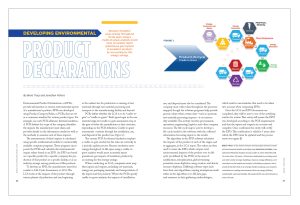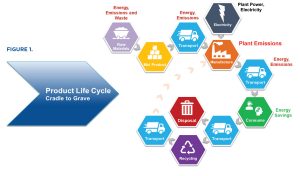Developing Environmental Product Declarations (EPDs)
Environmental Product Declarations, or EPDs, provide information on various environmental aspects of a manufacturer’s product. EPDs are developed using Product Category Rules, or PCRs, that are set as a consensus standard for various product types. For example, one such PCR addresses thermal insulation. A PCR defines the scope of the category, identifies the impacts the manufacturer must share, and provides details on the information needed as well as the methods to measure each of these impacts.
The measurement of these impacts is calculated using specific mathematical models in commercially available computer programs. These programs incorporate the PCRs and calculate the environmental impact values found in an EPD. An EPD can based on a specific product by a specific company, the production of that product at a specific facility, or as an industry average among producers of like products.
To develop an EPD, the manufacturer must first conduct a Life Cycle Assessment, or LCA. The LCA looks at the impacts of the product through various phases of production and use, beginning at the earliest tier for production or mining of raw materials through raw material processing and transport to the manufacturing facility and beyond.
PCRs define whether the LCA is to be “cradle-to-gate” or “cradle-to-grave.” Both types begin in the raw material stage, but cradle-to-gate assessments stop at the gate of either the manufacturer or first customer, depending on the PCR definition. Cradle-to-grave assessments continue through the installation, use, and disposal of the product (see Figure 1).
The current PCR for thermal insulation employs a cradle-to-gate model, but the rules are currently in a periodic update process. Because insulation saves energy throughout its life span, using a cradle-to-grave analysis would more accurately report greenhouse gas impacts of insulation products by accounting for this energy savings.
When conducting an LCA, companies must map their inputs and outputs, including raw materials, energy use, packaging materials, and transportation of the inputs and the products. Where the PCRs specify cradle-to-grave analysis, the impacts of installation,
use, and disposal must also be considered. The company must collect data throughout the processes mapped, though the software programs help provide generic values when certain data—such as upstream raw material processing impacts—is not reasonably available. This activity involves procurement, operations, engineering, logistics, and other company resources. The life-cycle map is used to develop a life-cycle model in the software, with the collected information becoming inputs to the model.
The algorithm in the EPD software calculates the impacts of the product at each of the stages, and in aggregate, in the LCA report. The values are then used to create the EPD, which outputs total environmental impacts of the product over its life cycle (as defined by the PCR) in the areas of acidification, eutrophication, global warming potential, ozone depletion, smog creation, and abiotic resource depletion. Differing software types each have their own algorithms, varying assumptions made either in the algorithm or to fill data gaps, and variances in data-gathering methodologies, which result in uncertainties that need to be taken into account when comparing EPDs.
Once the LCA and EPD documents are completed, they will be sent to one of the certifying entities for review. That entity will ensure the EPD was developed according to the PCR requirements and that the inputs and outputs are accurate and complete. Once confirmed, the entity will certify the EPD. This certification is valid for 5 years, after which the EPD must be updated and the process starts over again.


